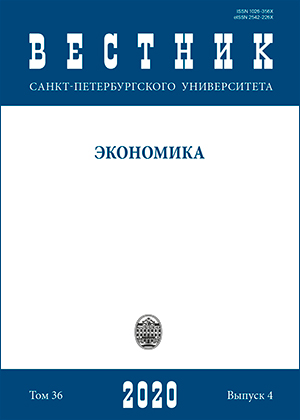The Role of the Embargo in the Russia’s Agricultural Trade Policy
Abstract
This article makes contribution to the methodology of non-tariff measures assessment. The proportions between the parameters of the two gravity equations describing the situation before and after the embargo were used. The ratio of imports over the two compared years was not the same as the ratio of GDP between two groups of trading partners, one of which was free-trade partners and the other was the rest of the world. This difference, which, in the absence of an embargo, could be explained by the impact of the customs tariff, since it was assumed that sanitary and phytosanitary measures were applied in all cases, in the presence of an embargo was increased by the emergence of a new trade barrier. This permits to estimate trade bans quantitatively.
Null hypothesis of the work was as following: the impact of selective embargo on imports is not superior to that of tariff and phytosanitary measures. In other words, the import substitution regime (also known as special economic measure), which has been introduced in 2014, does not dominate over ordinary trade regulation. The null hypothesis is rejected. After analyzing in dynamics the null hypothesis can be clarified as follows: among other trade barriers the trade embargo was the dominating cause of the effect of import substitution in 2016 when it had highest level, but this position is unstable.
Keywords:
special economic measure, trade embargo, non-tariff measures, import substitution, gravity equation, international trade
Downloads
References
Askari H., Forrer J., Teegen H. and Yang J. (2003) Case Studies of U.S. Economic Sanctions: The Chinese, Cuban, and Iranian Experiences. Praeger. 304 p.
Bora B. (2005) The Quantification and Impact of Non-Tariff Measures. In: The Effects of Non-Tariff Measures and Trade Facilitation. APEC Secretariat and World Scientific Publishing Co. Pte. Ltd. 674 p.
Chaney T. (2017) The Gravity Equation in International Trade: An Explanation. Copyright The University of Chicago. Preprint.
Czaga P. (2005) OECD Trade Policy Studies. The Role of Non-Tariff Barriers in World Trade. In: Looking Beyond Tariffs. Import Prohibitions and Quotas. OECD Publications. 304 p.
Deardorff, A. V. and Stern R. M. (1998) Measurement of Nontariff Barriers. University of Michigan Press. 152 p.
Dee P. and Ferrantino M. (2005) Introduction. In: The Effects of Non-Tariff Measures and Trade Facilitation. APEC Secretariat and World Scientific Publishing Co. Pte. Ltd. 674 p.
Fagiolo G. J. (2010) The International-Trade Network: Gravity Equations and Topological Properties. Econ Interact Coord, no.5. pp. 1-25. URL: https://doi.org/10.1007/s11403-010-0061-y
Head K. and Mayer T. (2013) Gravity Equations: Workhorse, Toolkit and Cookbook. CEPII Working Paper, no.27. 70 p. URL: http://www.cepii.fr/pdf_pub/wp/2013/wp2013-27.pdf
Helpman E. (2017) Understanding Global Trade. Moscow. University of Gaidar Institute. 312 p.
Herrmann-Pillath C. (2006) The True Story of Wine and Cloth, or: Building Blocks of an Evolutionary Political Economy of International Trade. J Evol Econ, no.16. pp. 383-417.
Hoekman B. (1995) Assessing the General Agreement on Trade In Services. In: Martin W. and Winters L. A. eds. The Uruguay round and the developing economies. World Bank Discussion Paper.307 p.
Hufbauer G. C., Schott J. J., Elliott K. A. and Oegg B. (2009) Economic Sanctions Reconsidered. Third Edition. Peterson Institute of International Economics. 248 p.
Korhonen I, Heli S. and Solanko L. (2018) Sanctions, Counter-Sanctions and Russia − Effects on Economy, Trade and Finance. Bank of Finland (BOFIT) Policy Brief, no. 4. 30 May. URL: https://helda.helsinki.fi/bof/bitstream/handle/123456789/15510/bpb0418.pdf?sequence=1
Kutlina-Dimitrova Z. (2015) The Economic Impact of the Russian Import Ban: a CGE Analysis. Trade. Chief economist note, Issue 3. URL:https://trade.ec.europa.eu/doclib/docs/2015/december/tradoc_154025.pdf
Livshitz V. N. and Livshitz S.V. (2011) Systems Analysis of Russia 's Non-Stationary Economy (1992-2010): Market Reforms, Crisis, Investment Policy. 2nd ed. Moscow: Maroseyka. 510 p.
Mitsuyo A. (2005) Estimating Tariff Equivalents of Core and Non-Core Non-Tariff Measures in the APEC Member Economies. In: The Effects of Non-Tariff Measures and Trade Facilitation. APEC Secretariat and World Scientific Publishing Co. Pte. Ltd. 674 p.
Oranen T. (2017) Russian Counter-sanctions and Trade Deflection: Evidence from Finland. Master’s essay (First year). Department of Economics Lund University. URL: http://lup.lub.lu.se/luur/download?func=downloadFile&recordOId=8928030&fileOId=8928031
Rauch F. (2016) The Geometry of the Distance Coefficient in Gravity Equations in International Trade. Review of International Economics, no. 24(5). pp.1167-1177.
Serrano R. and Pinilla V. (2012) The Long-Run Decline in the Share of Agricultural and Food Products in International Trade: a Gravity Equation Approach to its Causes.Applied Economics, no. 44:32. pp. 4199-4210.
Shagaida N.I. and Uzun V.J. (2017) Trends and Main Challenges of the Agricultural Sector of Russia: Analytical Report. Center for Strategic Development. Moscow. 88p. URL: https://www.csr.ru/wp-content/uploads/2017/11/Doklad_selskoe_hozyai-stvo_veb.pdf
Tinbergen J. (1962) Shaping the World Economy. New York: Twentieth Century Fund.
Trade Statistics in Policymaking. (2009) A Handbook of Commonly Used Trade Indices and Indicators. Revised Edition. UN Economic and Social Commission for Asia and the Passific. URL: https://www.unescap.org/sites/default/files/0%20-%20Full%20Report_27.pdf
Zhiryaeva E.V. and Naumov V.N. (2018) Global and Glocal Trade Streams Assessment in the Subjects of the Northwestern Federal District Trade.Management Consulting. no. 5. pp. 113-129. URL: https://www.acjournal.ru/jour/article/view/863/858
Zhiryaeva E.V. (2018) Regulation of Foreign Economic Activity at the Regional Level in Global Conditions of the WTO. The abstract of the thesis for a degree of the Doctor of Economics. St. Petersburg. 39 p. URL: https://disser.spbu.ru/files/disser2/1586/aftoreferat/BzvY3G3YCY.pdf
Published
How to Cite
Issue
Section
License
Articles of the St Petersburg University Journal of Economic Studies are open access distributed under the terms of the License Agreement with Saint Petersburg State University, which permits to the authors unrestricted distribution and self-archiving free of charge.






